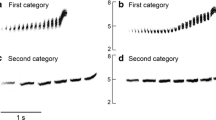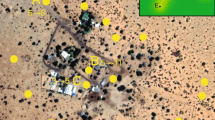Summary
The importance of singing in the establishment and maintenance of dominance rank was investigated in captive flocks of brown-headed cowbirds (Molothrus ater). Each flock consisted of 3 males and 1 female. In one experiment the two largest males in each of 4 flocks were temporarily devocalized by puncturing the interclavicular air sac just before group formation. The third male in each group was sham-operated. There was a significant tendency for the non-devocalized birds to become the dominant member of their group. Only sham-operated males sang immediately after the operation. In a second experiment, dominant males from flocks with established hierarchies were temporarily devocalized. None of these males lost their dominant positions, despite their inability to sing. These results suggest that song is important in the establishment of dominance rank; however, once established, social hierarchies may be maintained by non-vocal means, such as social inertia or individual recognition.
Similar content being viewed by others
References
Adkins-Regan EI (1981) Hormone specificity, androgen metabolism, and social behavior. Am Zool 21:257–272
Altmann J (1974) Observational study of behavior: sampling methods. Behaviour 49:227–265
Arnold AP (1975) The effects of castration and androgen replacement on song, courtship, and aggression in zebra finches (Poephila guttata). J Exp Zool 191:309–326
Balthazart J (1983) Hormonal correlates of behavior. In: Farner DS, King JR, Parkes KS (eds) Avian biology, vol 7. Academic Press, New York, pp 221–365
Catchpole CK (1982) The evolution of bird sounds in relation to mating and spacing behavior. In: Kroodsma DE, Miller EH (eds) Acoustic communication in birds, vol 1. Academic Press, New York, pp 297–319
Chase ID (1982) Dynamics of hierarchy formation: the sequential development of dominance relationships. Behaviour 80:218–238
Darley JA (1978) Pairing in captive brown-headed cowbirds (Molothrus ater). Can J Zool 56:2249–2252
Darley JA (1982) Territoriality and mating behavior of male brown-headed cowbirds. Condor 84:15–21
Darwin C (1871) The descent of man, and selection in relation to sex. John Murray, London
Dufty AM Jr (1982a) Movements and activities of radiotracked brown-headed cowbirds. Auk 99:316–327
Dufty AM Jr (1982b) Response of brown-headed cowbirds to simulated conspecific intruders. Anim Behav 30:1043–1052
Dufty AM Jr (1985) Song sharing in the brown-headed cowbird (Molothrus ater). Z Tierpsychol 69:177–190
Fankhauser DP (1971) Annual adult survival rates of blackbirds and starlings. Bird-Banding 42:36–42
Friedmann H (1929) The cowbirds. CC Thomas, Springfield, Ill
Guhl AM (1964) Psychophysiological interrelationship in the social behavior of chickens. Psychol Bull 61:277–285
Harding CF (1981) Social modulation of circulating hormone levels in the male. Am Zool 21:223–232
King AP, West MJ (1977) Species identification in the N.A. cowbird: appropriate responses to abnormal song. Science, NY 195:1002–1004
Krebs JR (1977) Song and territory in the great tit. In: Stonehouse B, Perrins C (eds) Evolutionary ecology. Macmillan, New York, pp 47–62
Peek FW (1972) An experimental study of the territorial function of vocal and visual display in the male red-winged blackbird (Agelaius phoeniceus). Anim Behav 20:112–118
Ramenofsky M (1984) Agonistic behaviour and endogenous plasma hormones in male Japanese quail. Anim Behav 32:698–708
Rothstein SI (1972) Territoriality and mating system in the parasitic brown-headed cowbird (Molothrus ater) as determined from captive birds. Am Zool 12:659 (abstract)
Sapolsky RM (1983) Endocrine aspects of social instability in the olive baboon (Papio anubis). Am J Primatol 5:365–379
Schuurman T (1980) Hormonal correlates of agonistic behavior in adult male rats. Prog Brain Res 53:415–420
Searcy WA (1979) Morphological correlates of dominance in captive male red-winged blackbirds. Condor 81:417–420
Searcy WA, Yasukawa K (1983) Sexual selection and redwinged blackbirds. Am Sci 71:166–174
Smith DG (1977) The role of the sternotrachealis muscles in bird song production. Auk 94:152–155
Smith DG (1979) Male singing ability and territorial integrity in red-winged blackbirds (Agelaius phoeniceus). Behaviour 68:191–206
West MJ, King AP (1980) Enriching cowbird song by social deprivation. J Comp Physiol Psychol 94:263–270
West MJ, King AP, Eastzer DH (1981a) Validating the female bioassay of cowbird song: relating differences in song potency to mating success. Anim Behav 29:490–501
West MJ, King AP, Eastzer DH (1981b) The cowbird: reflections on development from an unlikely source. Am Sci 69:56–66
West MJ, King AP, Eastzer DH, Staddon JER (1979) A bioassay of isolate cowbird song. J Comp Physiol Psychol 93:124–133
Wingfield JC (1985) Environmental and hormonal control of territorial behavior in birds. In: Follett BK, Ishii S, Chandola A (es) The endocrine system and the environment. Jap Sci Soc and Springer, Tokyo Berlin, pp 265–277
Yasukawa K (1981) Song repertoires in the red-winged blackbird (Agelaius phoeniceus): a test of the Beau Geste hypothesis. Anim Behav 29:114–125
Author information
Authors and Affiliations
Rights and permissions
About this article
Cite this article
Dufty, A.M. Singing and the establishment and maintenance of dominance hierarchies in captive brown-headed cowbirds. Behav Ecol Sociobiol 19, 49–55 (1986). https://doi.org/10.1007/BF00303842
Received:
Accepted:
Issue Date:
DOI: https://doi.org/10.1007/BF00303842




